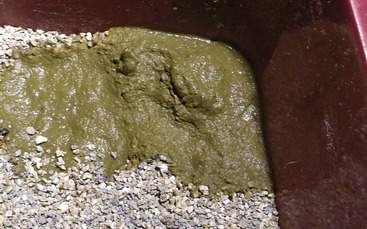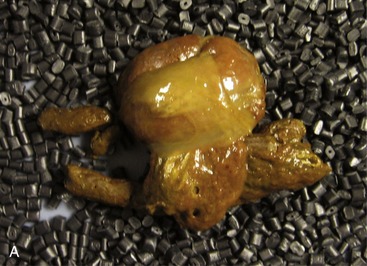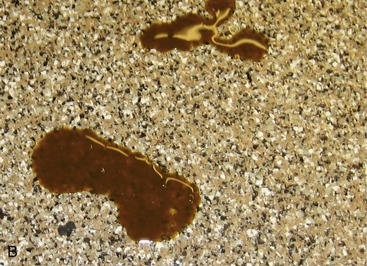CHAPTER 22 Therapeutic Approach to Cats with Chronic Diarrhea
When determining therapeutic options for chronic diarrhea, it is important to know if the diarrhea is small or large bowel in origin (Table 22-1). Small bowel diarrhea is characterized by large quantities of loose to watery stool, which usually occurs one to two times a day (Figure 22-1). Large bowel diarrhea is characterized by small frequent bowel movements often with blood or mucus present (Figure 22-2). In some cases the diarrhea will have characteristics of both small and large bowel diarrhea (i.e., large quantities but some mucus or blood). The author uses the term mixed bowel diarrhea to describe this combination.
Table 22-1 Clinical Differentiation of Large Bowel and Small Bowel Diarrhea
| Characteristic | Small Bowel Diarrhea | Large Bowel Diarrhea |
|---|---|---|
| Frequency of bowel movements | 1 to 2 times a day | Multiple times a day |
| Amount with each bowel movement | Large amounts | Usually small amounts |
| Melena | Yes | No |
| Blood/mucus in stool | No | Yes |
| Tenesmus | No | Yes |
| Weight loss | ± | Rarely |
| Vomiting | ± | No |
ANTIPARASITIC AGENTS
A complete diagnostic evaluation for chronic diarrhea in a cat should always include a fecal smear and flotation. A Giardia fecal enzyme-linked immunosorbent assay (ELISA) test also may be beneficial. Even with negative results, it is essential to treat all patients with a broad-spectrum anthelminthic agent. The author uses praziquantel and pyrantel pamoate frequently in combination. One study evaluated the use of a combination of febantel, praziquantel, and pyrantel pamoate for the treatment of Giardia infection in cats. This combination therapy with febantel 56.5 mg/kg PO, pyrantel pamoate 11.3 mg/kg PO, and praziquantel 37.8 mg/kg PO for 5 days led to some success in treating giardiasis.1 Also, the authors found that there were minimal complications, except for mild salivation after drug administration. Previous experiences with the same therapeutic protocol had shown transient neurotoxicity, which was not seen in this study.1 Therefore this combination may be used as a broad-spectrum anthelminthic in cats.
Specific anthelminthics are recommended for different parasitic infections (Table 22-2). The anthelminthics used most commonly in cats include pyrantel pamoate, fenbendazole, and praziquantel. Pyrantel pamoate is effective against Toxocara (roundworms) and Ancylostoma (hookworms). Fenbendazole is effective for these nematodes, as well as Strongyloides (seen rarely in cats) and Trichuris (whipworms). Praziquantel is effective against Dipylidium caninum (tapeworms) and Alaria (the intestinal fluke). Alaria often is nonpathogenic and may not require therapy. It is important to note that the feline tapeworm, D. caninum, should be treated with praziquantel.
Protozoal infections that can cause chronic diarrhea in cats include Giardia lamblia, Tritrichomonas foetus, Isospora felis and Isospora rivolta, and Cryptosporidium parvum (see Chapter 18). A variety of protocols have been evaluated for the treatment of Giardia infections in cats. To date, metronidazole administered at 25 mg/kg PO q12h for 7 days has been shown to be most effective in eliminating Giardia cysts long term.2 In one study none of the treated cats developed clinical signs of metronidazole toxicity at this dosage. However, it should be noted that this high dose was used only for 7 days.2 Other therapies, such as fenbendazole and the combination treatment described in the preceding, have caused a decrease in the numbers of Giardia cysts, but not long-term resolution in all infected cats.1,3 Also, Giardia vaccines have not shown efficacy in preventing giardiasis in cats.4
T. foetus is a protozoal organism causing infections that have been diagnosed with increasing frequency in cats over the last 10 years. The condition is self-limiting in many patients. However, it may take 9 months on average for resolution of clinical signs, and up to 2 years in some cats.5 Currently ronidazole is considered the treatment of choice; however, neurotoxicity can develop and ronidazole should be used with caution. All cats with reported neurotoxicity after ronidazole treatment had reversible signs, but based on similar findings with metronidazole, irreversible signs may occur in some patients.6,7
C. parvum is another protozoal infection that occurs in cats. No therapeutic protocols have been shown to eliminate Cryptosporidium successfully and consistently, although the infection often can be self-limiting. Isospora spp. infections can be treated successfully with sulfadimethoxine (50 mg/kg PO q24h on day 1, then 25 mg/kg PO q24h for 14 days), although it is a self-limiting disease in most cases. (See Chapter 15 in the fifth volume of this series for further discussion about the diagnosis and treatment of these parasitic infections in young cats.)
NUTRITION
Nutrition is extremely important in the management of chronic diarrhea, and often is used alone or in conjunction with other therapies. This section briefly discusses nutritional options. Further information can be found in Chapter 8 of this volume.
Several dietary options are available for cats with chronic diarrhea, the first of which is a diet that is highly digestible and low in fat. These diets can be used in patients with small or large bowel diarrhea that are not the result of true food hypersensitivity. It is believed that unabsorbed fatty acids can lead to colonic water secretion, increased diarrhea, and water loss. However, fat is important as an energy source and high-fat diets are energy dense, which can be important for patients with chronic diarrhea. Therefore a moderate level of fat in the diet, approximately 15 to 22 per cent on a dry matter basis, is recommended for cats with small or large bowel chronic diarrhea.8 However, cats with small bowel diarrhea may be able to tolerate higher dietary fat than dogs, and preliminary data suggest that low-carbohydrate, high-fat diets may be beneficial in some cats with chronic small bowel diarrhea.8 Further studies are needed to validate these observations.
Several veterinary diets are highly digestible with low-fat content. Other options include boiled chicken, canned chicken in water, low fat deli meats, or baby foods, such as puréed chicken or turkey. Rice or corn can be used as a carbohydrate source, but it is often difficult to persuade cats to eat carbohydrates. If a homemade diet is to be used on a long-term basis, it is recommended that a nutritionist be consulted so that a balanced homemade diet is formulated for the patient (see Chapter 13).
Novel protein and hydrolyzed protein diets also can be used for cats with inflammatory bowel disease or food hypersensitivity. Novel protein diets have a single source of protein and a single source of carbohydrate, both of which should be new to the affected cat. This is important because all sources of carbohydrates contain a small amount of protein that can act as an allergen and cause food hypersensitivity. Hydrolyzed protein diets contain protein that has been broken down into small peptides that are less than 15,000 Daltons in size. It is important to note that the average size of the peptides in each of the diets may vary, and therefore the level of antigenicity also may vary between diets. Novel protein and hydrolyzed protein diets are used most commonly in cats with small bowel diarrhea, but they also can be used in cats with lymphocytic-plasmacytic colitis, which also may be caused by food hypersensitivity.8 Several diets on the market contain novel or hydrolyzed proteins. It may take up to 6 to 8 weeks until a complete remission is achieved after initiating the diet; however, at a minimum, a partial response must be observed in the first 1 to 2 weeks of dietary therapy.
Stay updated, free articles. Join our Telegram channel

Full access? Get Clinical Tree






 to
to  tsp PO q12h) often is effective in cats with large bowel diarrhea (and sometimes small bowel diarrhea), and can be added to any of the diets described above. Psyllium is unflavored and is accepted readily by most cats because it does not change the flavor of the food. It is important to note that response to a particular diet usually is not predictable, and several diets often need to be evaluated in a feeding trial before the most effective diet for an individual patient is identified.
tsp PO q12h) often is effective in cats with large bowel diarrhea (and sometimes small bowel diarrhea), and can be added to any of the diets described above. Psyllium is unflavored and is accepted readily by most cats because it does not change the flavor of the food. It is important to note that response to a particular diet usually is not predictable, and several diets often need to be evaluated in a feeding trial before the most effective diet for an individual patient is identified.